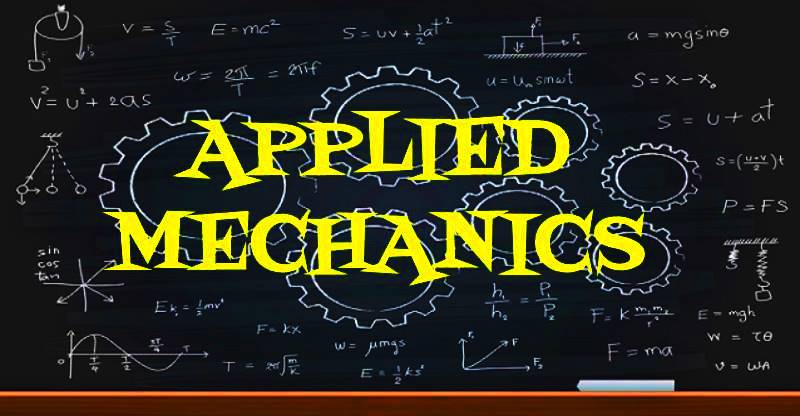LAW OF FORCES
CLASSIFICATION OF FORCES:
Classification of forces acting on a system or body is done on the following basis:
-
According to area of action:
- Concentrated Force: A concentrated force is one whose place of application is so small that it may be considered as a point.
-
- Distributed Force: A distributed force is one whose place of application is on an area.
-
According to whether the force is at a distance or by contact:
- Non-contacting force or forces at a distance: Magnetic , electrical and gravitational forces are examples of non-contacting forces.
-
- Contacting forces or forces by contact: The pressure of steam in a cylinder and that of the wheels of a locomotive on the supporting rails are examples of contacting forces.
-
According to the effect produced by the force:
- External Force: An external force is one which produce external effects e.g. push or pull in the body on which it acts.
-
- Internal Force: An internal force produces internal stresses in the body on which it acts and causes deformation of the body.
-
- Active Force: A force which causes a body to move or change its shape is called an active force.
-
- Passive Force: A force which prevents the motion ort deformation of a body is called a passive force.
-
According to the nature of the force:
- Action and Reaction: Whenever there are two bodies in contact, each exerts a force on the other. One of these forces is called action and other is called reaction. Action and reaction are equal and opposite, and when the bodies are smooth, they act normal to the surface in contact.
-
- Attraction and Repulsion: These are actually non-contacting forces exerted on the body on another without any visible medium of transmission such as magnetic forces, electric forces and gravitational force.
-
- Tension and Thrust: If we drag a body through string, them the force communicated to the body by the string is called tension while if we push the body with a rod, the force exerted on the body is called thrust.
-
According to he nature of stress produced in the body:
- Tensile forces: When two equal and opposite forces having same line of action tend to increase the length of the body, the forces applied are known as Tensile Forces.
-
- Compressive forces: When two equal and opposite forces having same line of action tend to decrease the length of the body, the forces applied are known as Compressive Forces.
-
- Shear forces: When two equal and opposite forces having different lines of action tend to cause angular distortion in the body; the forces applied are known as shear forces.

PRINCIPLES OF TRANSMISSIBILITY:
The principle of transmissibility states that if a force acts at a point in rigid body, it may be considered to act at any other point of the body on the line of action of the force. In other words, the external effect of the force is independent of the point of application along its line of action.
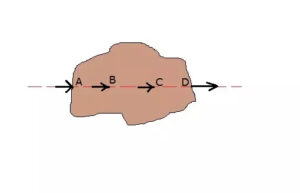
Consider a body in which a force F is acting on a body. On the line of action of force if the force F is removed from point A and placed at point B or C or D, the effect produced by the force will remain the same. This property of the force is called TRANSMISSIBILTY.
FORCE SYSTEM:
If a number of forces area acting on a body, then it is said that a force system is acting on the body. So, a force system is a collection of forces acting on a body.
Classification of a force system:
(a) Coplanar Force System (b) Non-Coplanar Force System
(a) Coplanar Force System: The force system in which all the forces lies in the same plane is known as coplanar force system. The coplanar force system can be further classified as:
(i) Coplanar Collinear: When the forces in a force system lie in the same plane and have the same line of action, then the force system is called Coplanar Collinear Force system.
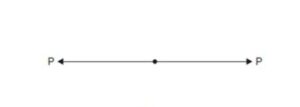
(ii) Coplanar Concurrent: When the forces in a force system lies in the same plane and are acting through the same point.
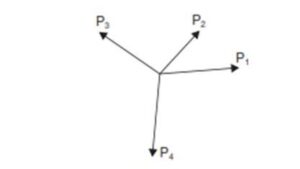
(iii) Coplanar Parallel: When the forces in a force system lies in the same plane and the line of action of the forces are parallel to one another.

(iv) Coplanar Concurrent Collinear: When the forces in a force system lies in the same plane and all the forces have same line of action and act through same point.
(v) Coplanar Concurrent Non-Parallel: When the forces in a force system lies in the same plane, acts through same point and line of action of all the forces meet at a point but have different directions.
(vi) Coplanar Non-Concurrent Parallel: In this force system, the lines of action of all the forces lie in the same plane and are parallel to each other but may not have the same direction.
(vii) Coplanar Non-Concurrent Non-Parallel: In this force system, the lines of action of all the forces are in the same plane but are not parallel, do not meet at a point and may not have the same direction.
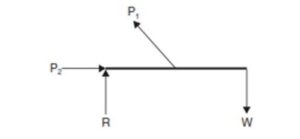
Coplanar Non-Concurrent Non-Parallel
(b) Non-Coplanar Force System: The force system in which the forces do not lie in the same plane is known as non-coplanar force system. The non-coplanar force system can be further classified as:
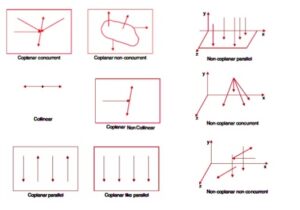
(i) Non-Coplanar Concurrent: In this force system, the lines of action of all the forces meet at a point but do not lie in the same plane.
(ii) Non-Coplanar Non-Concurrent Parallel: In this force system, the lines of action of the forces are parallel, they do not meet at a point and also are not in the same plane.
(iii) Non-Coplanar Non-Concurrent and Non-Parallel: In this force system, the lines of action of the forces are not parallel, they do not meet at a point and also are not in the same plane.
RELATED VIDEOS FOR CLASSIFICATION OF FORCES:
